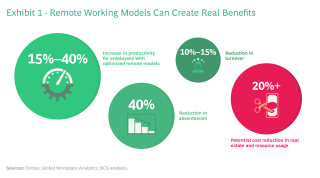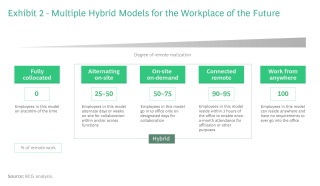Remote Working Works
Remote Work Works—Where Do We Go from Here?
COVID-19 has shown us what organizations can accomplish. Just days after the illness caused by the novel coronavirus was officially labeled a pandemic, many had managed to get more than 90% of their staff working remotely. Jobs that we never imagined could be performed remotely—like call center operator, financial trader, and many more—suddenly and successfully were handled from home. Now, in many places, pandemic-associated restrictions are easing and companies are turning their attention to bringing people back to the workplace.
The obvious and immediate question for many organizations is, “How can we safely bring employees back to the workplace?” But leaders must expand their thinking when considering the work environment of the future. Because the rabbit is out of the hat: remote working works, and it has obvious benefits. (See Exhibit 1.) We can’t help but wonder what role it should continue to occupy. It’s imperative to start with a clean slate and reconfigure the “workplace” of the future. We urge organizations to stop and reflect before bringing any workers (beyond the first wave of critical returnees) back and instead pause to set a long-term ambition for the future of work.
SETTING THE LONG-TERM AMBITION
Many leaders are indeed taking a long-term view and asking themselves what’s next for remote work within their organization. BCG’s recent Workplace of the Future survey reveals that most organizations believe their future workforce will be much more remote than ever before:
- Overall, companies expect approximately 40% of employees to utilize a remote working model in the future.
- Thirty-seven percent of companies expect that more than 25% of employees will work in hybrid models that combine remote and onsite work.
(The Workplace of the Future survey focuses on employee roles and jobs that are not heavily dependent on work sites or plants, such as retail stores, manufacturing sites, and select service sectors; these roles and jobs are addressed in “Restarting Work Safely and Under Control.”)
It is clear that remote work will grow in the future, but it is up to leadership to set a bold yet sustainable vision for how that will happen. Here’s how to shape that vision.
Consider multiple versions of “remote.” Remote work doesn’t have to mean that all or most employees always work from home. Remote work can be structured so that employees split their time between home and the workplace, on alternate weeks and on a rotating schedule. It can include designated times for everyone to be physically present—for instance, there might be good reason for everyone to be on site on, say, Wednesdays or throughout the first week of every month. Or a company could choose a work-from-anywhere model in which employees can work remotely all the time but still be able to visit any work location anytime, if they wish to do so for the purpose of affiliation. (See Exhibit 2.)
Take a job-by-job or function-by-function approach. Because jobs differ, the need for collocation differs too. Consider the nature of the work (some jobs or functions require in-office equipment), the need for interaction (for live supervision or brainstorming, for instance), and so on.
Mapping jobs and functions to various models of remote work will help to crystallize the opportunity for each group and geographic area and to determine which work and workers can be remote for the foreseeable future and which should be collocated. To do this, organizations should consider five key characteristics of work. Indeed, we use this set of drivers when diagnosing remote opportunities for our clients. Building from that examination, teams and functions within companies must consider how they would choose to apply remote, onsite, or hybrid working models given their specific day-to-day needs and unique environment.
- Onsite Client Interaction. Consider the degree to which each individual job requires an employee to interact live with customers. Take into account customer migration during the pandemic and whether customers will stay virtual. Relevant jobs include face-to-face sales roles and receptionists.
- Specialized Equipment and Facilities. To what degree does a particular job require the use of certain onsite equipment or facilities? This is a particular consideration for manufacturing and worksite management roles, among others.
- Supervision and Regulatory Oversight. Some jobs require close supervision from a superior, given the importance of accuracy in the work performed or because regulatory requirements make this the best practice. Auditor and data specialist roles are among the jobs that could fall into this category.
- Collaboration and Interaction. Think about how much collaboration or interaction with other employees is required, whether in the same job function or across functions. Project managers and operations leads are examples of jobs likely to emphasize collaboration and interaction.
- Innovation. How important is innovation in a particular role? Does it tend to result in better outcomes? Given jobs where this might be a consideration include engineering roles and marketing specialists.
ENSURING TOMORROW’S REMOTE SUCCESS TODAY
A remote-working ambition is a step toward reenvisioning what work can and should be in the future. But that ambition does not always ensure remote success now without proper planning. In every organization, remote working is functioning well in some areas and not so well in others. There’s a lot to be learned from the successes. Remember: the shift to remote work happened in a matter of days or weeks and required people to use new digital tools that they weren’t necessarily comfortable with. Absent training, coaching, and time to learn all the tricks, it was trial by fire. Some mastered the shift better than others. As restrictions fall in this prevaccine time, we can and should assess multiple hybrid models that mix remote and onsite work and learn from recent experience.
Tackling the complexity presented by hybrid models by choice will be much more challenging than the initial shift to full remote for nonessential workers, which was an act of necessity. Paying attention to core needs across six domains can ensure the effectiveness of remote working. (See Exhibit 3.)
Routines, Tools, and Capability Building. At the brink of the pandemic, organizations rushed to provide new collaboration tools and working routines that would enable their employees to rapidly adapt to working from home. But did these tools and routines succeed?
It is time to assess what worked and what didn’t. Were Zoom breakout rooms better than collaboration tools like Trello, for instance? Identifying and understanding how and why certain tools are being used (or are not being used) will allow teams to address issues. Studying highly effective teams and their behaviors, routines, and use of tools can help managers across the organization scale best practices across teams. What capabilities—specific knowledge, skills, and attitudes—do these employees and leaders have? How can the organization enable them to teach others? Rarely do tools alone suffice. People need to undertake deliberate practice to build new habits and muscles to get the full value of any change.
Cybersecurity and Internal Data Security. If employees are working from home on unsecured networks, the risk of external cyber threats is increased, which means that organizations will need more cybersecurity experts. This need will grow as more employees work in a hybrid environment; unpredictable environments increase the risk of security breaches.
Additionally, the limited supervision of remote workers, even for critical tasks, heightens the company’s vulnerability to data security issues internally. To reduce data security risk, companies must ensure that they restrict access to sensitive information to select employees, institute data access expirations, implement multistep (and multiperson) approval processes for any information sharing, and limit access to sensitive information to certain working hours. Only 30% of cybersecurity is technology. The other 70% is culture, behavior, and awareness. Developing programs to build a cyber- and data-secure culture must be on the immediate priority list.
Coaching and Development. Informal coaching moments that might have happened at the end of meetings have given way to quick transitions from one call to the next. Teams and leaders need to make time to give feedback for the sake of coaching and development. They need to find moments of spontaneity to check in with colleagues.
Leaders must also ensure that they dedicate comparable attention to onsite and remote employees.
There is also a clear need to ensure that teams continue to grow and learn during these times, given the rapid-fire rate of change and the focus on execution. It is important that leaders adjust their thinking and be deliberate and thoughtful when coaching their staff and each other.
Productivity and Performance Management. Being present is not the same as being effective and productive. Companies may have implicitly married presence to performance in the past, but they have been forced to change this notion in the new remote environment. Remote work has helped move performance metrics from inputs to outputs. For roles that do not have quantitative output measures, companies like Apple and USAA have leveraged net promoter scores from internal customers to serve as important measures of productivity.
Effectively measuring productivity is just a single piece in the broader performance management puzzle. Companies must recognize that the daily tasks and performance targets of many roles have changed dramatically as a result of the pandemic-induced workplace shifts. One key to performance management will be adjusting productivity and performance expectations to align with changing roles and updated company performance goals that come with the shifting economic and social environment.
Leaders must also institute a process for reviewing how promotions, bonuses, and overall performance scores compare across remote and onsite employees. Introducing this process will ensure that employees are evaluated and rewarded in a comparable manner.
Senior Leadership and Culture. In the face of COVID-19, organizations came together and acted swiftly and across boundaries to get things done. That positive culture should be sustained. Companies can also treat this time of flux as an opportunity to eliminate lingering negative aspects of the past culture: face time, hierarchy, personal connections, and lack of diversity.
With everyone working remotely, leaders have had to find new ways to connect and build virtual social intimacy. Those efforts have paid off. COVID-19 has leveled the playing field for remote and flex workers. They no longer struggle to have their voices heard in a meeting or miss out on hallway chatter and the social bonding that happens before and after meetings. The relationship between company leaders and the workforce is different now too. Leaders are no longer in their intimidating executive suites. They are on screen from home, with kids and pets in the background and needing haircuts just like everyone else.
To reap the benefits of remote work, leaders must take action to maintain and even improve the positive culture. They should model the change and work remotely as well, using a hybrid model. For instance, they might work remotely for two days a week. Organizations are looking to the C-suite more than ever.
Recruiting and Onboarding. Tomorrow’s workforce is just as important as today’s. While it is natural for leaders to spend a large majority of their time thinking about how best to position their existing employees for success in remote settings, they must not lose track of how to adjust the recruitment and onboarding of new employees in a remote setting.
For recruiting, HR leaders can accelerate tech-enabled recruiting methods, such as video interviewing, automated resume review, and gamified evaluations. For onboarding, companies need to determine what a remote “day 1” and “onboarding week” will entail. Virtual coffee chats, welcome videos with greetings from current employees, and virtual networking can work wonders to foster engagement and immediate buy-in.
No matter the recruiting and onboarding approach taken, leaders must be sure that best practices are shared across the organization to enable a standardized approach and clear expectations moving forward.


